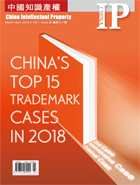CIVIL CASE
CASE 1 :
STIHL’S COLOUR COMBINATION TRADEMARK REGISTRATION
◆ First instance: (2017) Jing 73 XingChu No. 6150
Beijing Municipal
[Headnotes]
The Court affirms the registrability of the applied trademark based on the following: 1. The applied trademark, although not intrinsically distinctive, has however acquired a strong distinctiveness through use so as to function as a source identifier for the applicant’s chainsaws. 2. The fact that Andreas Stihl’s earlier “orange and grey” color combination trademark has been approved for registration by the TRAB implies that the TRAB acknowledges the distinctiveness and registrability of the color combination applied to chainsaws. Even if the trademark, as filed, is a pure abstract representation of the two colors, the description filed together with the trademark application clarifies how the combination of colors is to be applied to the products. Therefore, since the two trademarks consist of the same colors used in identical positions, notwithstanding the case-by-case principle, it is essential to maintain the consistency of examination criteria.
[Synopsis]
Plaintiff: Andreas Stihl AG & Co.
KG Defendant: the Trademark Review and Adjudication Board (TRAB)
On August 7, 2018 the Beijing Intellectual Property Court (Beijing IP Court) rendered an administrative ruling affirming the distinctiveness and registrability of the abstract colour combination trademark “orange and grey” (registered trademark), filed on June 10, 2015 by Andreas Stihl AG & Co. KG (Stihl), in respect of chainsaws in class 7.
(Applied tardemark trademark)
The application was at first refused by the China Trademark Office (CTMO) for lack of distinctiveness. In June 2016, Stihl appealed to the Trademark Review and Adjudication Board (TRAB), arguing that (1) the applied abstract colour combination trademark has acquired secondary meaning through extensive use; and (2) Stihl had already obtained, in August 2015, the registration of another “orange and grey” position trademark in respect of chainsaws which proved that the applied trademark was registrable (previous registration).
(Previous registration)
The previous registration had been filed in 2011 and had been refused by the CTMO for lack of distinctiveness. Meanwhile, Stihl had engaged in several administration enforcement actions against an infringer producing and selling exact replicas of its chainsaws. The raid actions had been followed by two civil litigations, and judgements had been rendered in favour of Stihl, on the basis of unfair competition. These civil judgments had obviously contributed to convincing the TRAB of the distinctive character acquired by the combined colours, as applied on the chainsaws. The previous registration had been obtained from the TRAB, after a long procedure.
However, in spite of the previous registration, the TRAB upheld the CTMO decision, finding that: (1) the applied trademark cannot function as a source identifier, and (2) pursuant to the case-by-case examination principle, the registration of the earlier trademark cannot be taken into account in the assessment of the registrability of the new application. Stihl appealed to the Beijing IP Court in August 2018, the court overruled the TRAB decision.
[Judge's Comment]
Colour combination has been listed as a registrable sign since the 2001 version of the Trademark Law. However, in practice, the examiners are often tempted to refuse the trademark on account of its lack of distinctiveness and the history of this case is an example of how to register a colour combination trademark in China despite the difficulties.
According to the Trademark Examination and Adjudication Criteria 2016, applicants have to submit a colorized trademark representation and a detailed description of the mark, with the name and pantone numbers of the colours, as well as an explicit written statement on how the colour combination trademark is to be used in commercial activity.
There are two types of admissible representations for the colour combination trademark:
1. It can be a representation of the product itself, showing with dottedlines where the colours are to be applied. This is straightforward and easy for the examiners to apprehend. The only downside of this approach would be that, if the colours are used differently than as described in the application, the risk is having no protection at all.
2. Applicants may also opt to submit an abstract coloured block, like Stihl’s application in this case, with a detailed description about how the colours are combined and used on the products, but without specifying the shape of the product. This approach could bestow the registrant a broader protection scope. However, the difficulty of obtaining such a registration increases substantially.
Since colour combination trademarks are normally deemed as inherently non-distinctive, it is necessary to prove that such colour combination has acquired a “secondary meaning” through massive use and advertisement. It is like the recognition of the well-known trademark status. The applicant needs to submit evidentiary materials regarding the product market share, ranking, extensive and continuous sales and advertising. Meanwhile the main difficulty is to prove that the reputation has been acquired by the colour combination, independently of the word mark which is also used on the product and packaging. The examiner and/ or judge usually have doubts about two questions: (1) whether the registrant’s extensive sales and advertising have contributed to the reputation of the word mark, and (2) whether the colour combination, standing alone, has become a source identifier. To address such doubts, a market survey may be necessary.
In practice, however, since it may take years for the brand owner to go through the whole trademark registration process, claiming protection of trade dress, in unfair competition administrative or legal proceedings, may be more efficient in stopping infringements. In such actions, it is easier to demonstrate the likelihood of confusion. Meanwhile, the protection records by PRC courts ascertaining the colours as trade dress can be used to support the trademark applicant’s argument on the distinctiveness and registrability of its colour combination trademark.






